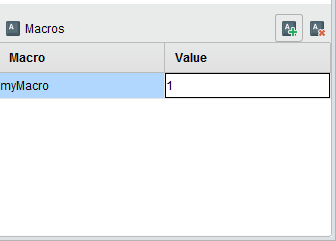How to Use Macros
 MartinLiebig
Administrator, Moderator, Employee, RapidMiner Certified Analyst, RapidMiner Certified Expert, University ProfessorPosts:3,439
MartinLiebig
Administrator, Moderator, Employee, RapidMiner Certified Analyst, RapidMiner Certified Expert, University ProfessorPosts:3,439In complex processes or projects with several processes, you often require to parametrize them using variables. Process variables in RapidMiner are called Macros. Macros are a powerful asset, which can be used to fully operationalize your analytics processes. Macros store what can be called primitive types. You can also store objects running through a connection. This can typically be done using Remember and Recall operators.
How to Set Macros
In general, there are two ways to set macros. The first way is using the context panel, the other is using operators.
The Context Panel
You can activate the panel by going to view->show panel and activating it. A common place to place this panel is next to the Parameter panel. In the context panel you can set new macros, by clicking on the small "+" button.

If you think about a single process like a programming function, this panel gives you the options to define the arguments of the function.
Best Practice: As a best practice we recommend to use a small letter in the beginning macros and than camel case, to identify macros easier.
Generating Macros using Operators
Besides setting macros in the context panel, you can also set and modify macros. If you search for Macro in the operator tree you can see a few operators handling macros. We will discuss the three most important ones.

Set Macrosets a macro very similar to the context menu to a constant value.
Generate Macrogives you the option to generate a macro with the interface you know from Generate Attributes. Using this operator you are for example able to generate a macro based on the current date (using the date_now() function).
Extract Macroextracts a macro from an example set. Often used options are to extract the number of examples of an example set, statistics like an average or a maximum or even single cell values of your example set.
How to Use Macros in General Operators
To use a macro anywhere in your process you can type %{myMacro}, which will be replaced by the current value of the macro. This is a real direct replacement and works in any value field in your process.

How to Use Macros in Generate Attributes
在生成属性和背包e Macros you have more options than just the %-Notation. Namely:
%-Notation
%{myMacro} inserts the current macro value as a string. If you have a string like foo stored in your macro you can do operations like
concat(%{myMacro},"bar"}
prefix(%{myMacro,1}
and so on. Keep in mind that you always interpret it as a string. If you store a 1 in you macro
concat(%{myMacro},"bar")
returns you 1bar. Operations like
%{myMacro} + 1
do not work.
Eval
The eval() evaluates the string of myMacro. If you have a 1 stored in your Macro you can do
eval(%{myMacro}+1
you get a two.
You can also put whole equations into the macro. If you store a sqrt(2) in you macro and calculate
eval(%{myMacro})
you get back a 1.41....
#-Notation
The #{attribute_macro} notation is in principle a shortcut for writting eval(%{attribute_macro}), which allows you to access the values of a given attribute.
But there are two importantant difference between the two:
* #{} will fail when the macro does not contain a valid attribute name
on the otherhand
* eval(%{attribute_macro}) will evaluate whatever is contained in the macro, which might fail e.g., if the attribute name conatins a "-"
The difference between the notations are shown in this process:
<连接from_port = " 1 " to_op = "生成Attributes (4)" to_port="example set input"/>
<连接from_port = " 1 " to_op = "生成Attributes (5)" to_port="example set input"/>
Add Comment Collap
Macros and Execute Process
You can use Macros to parametrize ex
Provided Macros
There are some macros already present which can be used throughout the process:
- %{process_name}: will be replaced by the name of the process (without path and extension)
- %{process_file}: will be replaced by the file name of the process (with extension)
- %{process_path}: will be replaced by the complete absolute path of the process file
- %{execution_count}: will be replaced by the number of times the current operator was applied.
- %{operator_name}: will be replaced by the name of the current operator.
- %{t}: will be replaced by the current time
Advanced Use Cases for Macros
- Parameterizing SQL Queries
- Parameterizing Web Services
- Using Macros in Web-Apps
Dortmund, Germany








Comments
Hi,
I'm trying to use user input from a website to populate my dataset with macros, but having a few bumps.
Can you help me?
Nice post!
I want to extract a date cell value. I suppose that the Extract macro operator changes the type of the value to nominal because when I generate a new attribute with this saved value I obtain a nominal type.
Do you know how save the date value keeping the date type when I try to recover the value?
我附上一个样本。
Thanks in advance,
Montse
Scott
I only wanted to know it there was another way to do it but this is good.
Best regards,
Montse
Lindon Ventures
乐鱼平台进入从认证RapidMiner数据科学咨询Experts
As@Telcontar120mentioned, it is really challenging to answer these kinds of questions, I think the user might have created another thread with a detailed explanation of his issue or he just left it. This is the reason we have a banner in "Ask a Question" page that suggests the ways of asking a good question, these are the best methods to get answers from the community.
Varun
https://www.varunmandalapu.com/
Be Safe. Follow precautions and Maintain Social Distancing
Scott
I'm sure we could all add to this list
Every software package has their own idiosyncratic vocabulary...I am not sure RapidMiner is much different in that way. I will say IMHO that at this point changing some of these fundamental vocabulary items would be horrendous...so much material has been built on it. But there is no harm in putting it on the ideas list
Scott